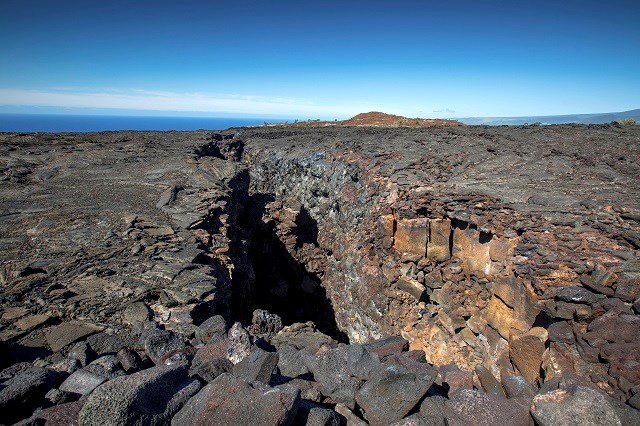Preserving Geological, Natural, and Cultural Treasures in the Southwest Rift of Kīlauea VolcanoHawai‘i Volcanoes National Park includes two parcels of land known as the Great Crack and Ala Waiʻi parcels. These parcels are situated in a remote region that encompasses the lower end of the Southwest Rift Zone of Kīlauea volcano. The park successfully acquired the first 1,951-acre parcel in 2018 and the second 2,750-acre parcel in 2022. These areas represent exceptional examples of the region's geologic dynamism, featuring a landscape dominated by barren lava rock with scarce surface water, limited tree growth, and little shade. 
NPS Photo/J.Wei The Great Crack

NPS Photo/J.Wei In 1823, an eruption caused lava to surge out from the lower section of the Great Crack and flow for about 6 miles (10 kilometers) into the ocean, destroying one small coastal village at Mahuka Bay. English Reverend William Ellis (1794-1872) and his company witnessed the aftermath of the eruption. A hundred years later, geologist Harold Stearns officially named it the "Keaiwa Flow," which was a name the residents of Ka‘ū had been using informally back then. The eruption was noteworthy because the extremely fluid lava moved rapidly and reached the ocean. As the lava flowed, it left a smooth coating on older structures, now referred to as the "Lava Plastered Cones." Interestingly, even when historically large earthquakes occurred, the Great Crack did not increase in size. The delicate 1823 lava flow remains intact, and did not show any signs of growth following the 7.9-magnitude earthquake of 1868, the largest documented earthquake in Hawaiʻi. Similarly, measurements taken during the 7.2-magnitude south flank earthquake in 1975 also revealed no changes in the area of the Great Crack. Ala Waiʻi
NPS Photo/D.Foster The cultural and natural history of this site remains shrouded in mystery due to its prolonged period of private ownership. It is believed that the site holds many archeological resources, encompassing early Native Hawaiian features. These invaluable resources signify the site's profound significance and sacredness, offering a unique chance to deepen our understanding of its past utilization, available resources, and the remarkable ways in which early inhabitants thrived amidst this vast expanse of lava. Determining Future Use of the Great Crack and Ala WaiʻiThe park is working to create a long-term plan for managing the Great Crack area. The park is exploring future public use options for these areas and will host a community meeting in Fall 2023 to learn from local residents about the site's resources and past uses.
No motorized vehicles and fires allowed. Overnight use requires a permit. Contact the backcountry office for more information at (808) 985-6178.
|
Last updated: September 21, 2023
